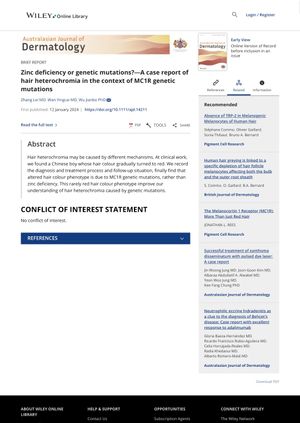Zinc Deficiency or Genetic Mutations? A Case Report of Hair Heterochromia in the Context of MC1R Genetic Mutations
January 2024
in “Australasian journal of dermatology (Print)”

TLDR A boy's hair turned red because of genetic mutations, not lack of zinc.
The document is a case report about a Chinese boy whose hair color gradually turned red, a condition known as hair heterochromia. After a thorough diagnosis, treatment process, and follow-up, it was determined that the change in hair color was due to MC1R genetic mutations, not zinc deficiency. This case contributes to the understanding of hair heterochromia caused by genetic mutations.
View this study on onlinelibrary.wiley.com →
Cited in this study
research Isolated Patchy Heterochromia With Pili Annulati Features on Light and Electron Microscopy
The study by Lobato-Berezo, Pesqué, and Pujol (2022) investigates a case of isolated patchy heterochromia with pili annulati features using light and electron microscopy. The findings reveal distinct structural characteristics of the hair, including alternating light and dark bands, which are indicative of pili annulati. This condition was observed without any associated systemic or dermatological disorders, suggesting that it can occur as an isolated phenomenon. The detailed microscopic analysis provided insights into the unique hair shaft abnormalities present in this rare condition.